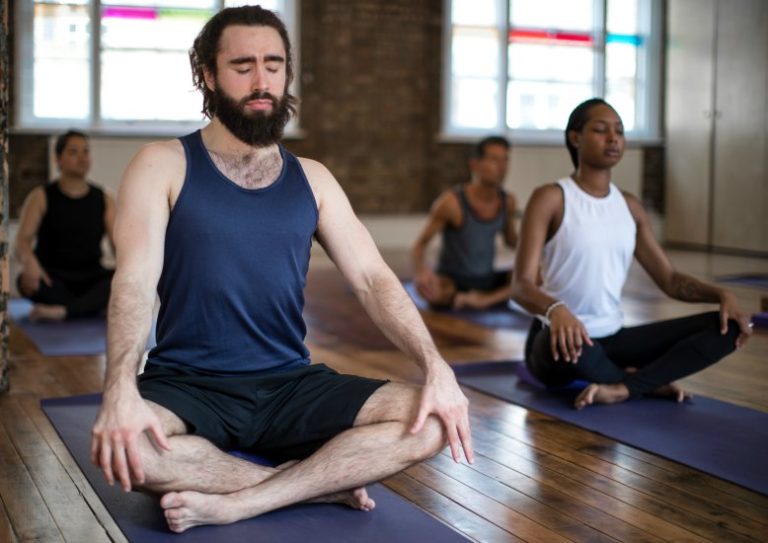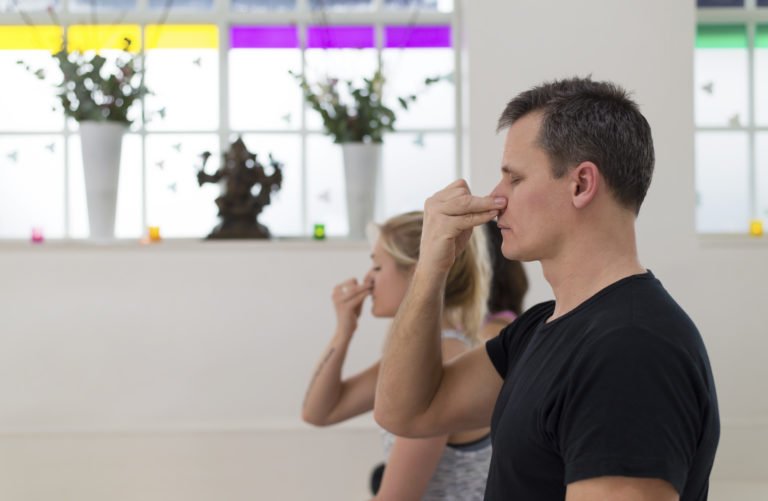Stress can be found in all corners of modern-day life. triyoga teacher James Rafael shares some alarming stats along with practical tools to carve out time to truly relax. He’ll dive deeper into movement-based meditation practices during his upcoming workshop ‘releasing stress through mindful movement’.
It’s a cold, grey London morning. The first hum of light is starting to rise through the scooted city walls like a tide line. With it comes the clatter of scaffolding, drunken cackling erupts from an alley. In the distance a red London bus is gasping as the city, gyroscopic, whirs into life. Morning commuters are already hitting the grindstone.
It’s not hard to feel the pressure in a place like this; do you ever get the feeling that stress and pace are somehow baked into the concrete of the city or town you live in? A 2018 UK study found that 74% of people have felt so stressed in the last year that ‘they have been overwhelmed or unable to cope’ . Read that again. Let it sink in: over two thirds of people are so stressed they feel they cannot physically cope. It’s alarming, but what can we do about it?
Often the prescription we’re given, is to meditate. But what if sitting still just makes you feel more stressed and anxious? If we’re travelling in a car at 70 miles per hour and we suddenly slam on the brakes, we know it’s going to be pretty jarring and unpleasant, right? For some of us, getting on the meditation cushion brings a certain sense of mental whiplash. If this is the case for you, a more skillful approach may be to reduce the speed gradually with slow, intention-based movements. Practices like Qigong, and slow, mindful Vinyasa yoga can serve to help us decelerate gradually, and move us into a more calm, centred space.
In order to make more room for these practices, however, we don’t want to add on to an already packed schedule. We’ll need to reprioritise and create a little space first. Many approaches to stress involve reducing commitments, delegating work or sacrificing family time, but for most of us, this simply isn’t feasible. What is feasible, however, is to determine if there are other areas where we lose small chunks of time in the name or relaxation, that are actually other sources of stress in disguise.
One of these areas may be our cluttered digital life. I’d argue that our digital ‘always-on’ culture has siphoned off the last vestiges of real down time and relaxation. We mistakenly think that watching TV, scrolling through social media, or unwinding with YouTube videos or podcasts is an effective, valid way to switch off. I don’t believe it is.
The problem I see with these forms of downtime is twofold: firstly, although these tools help distract us from our stress, that doesn’t mean they’re actually helping us process or work through it in the body; secondly, often the impact of these activities on the nervous system is once again one of over-stimulation. They can trigger the same aspect of the nervous system that causes spikes in adrenaline and cortisol and which is already overactive during the majority of our busy day-to-day lives.
Consider the content most widely consumed digitally: TV shows that centre on conflict, violence or drama of some sort; Facebook posts that are algorithmically engineered to serve you content that incites you towards strong emotional responses; Instagram posts that venerate an unattainable ideal of the ‘perfect’ life or body to silently erode your self-esteem. It’s a major problem when 49% of 18-24-year olds feel that one of the major sources of stress is comparing themselves to others – usually via social media. Even more shocking; that earlier data point regarding people feeling so stressed they were overwhelmed or unable to cope? For young people the percentage was even higher – 93% of them. That’s not ok. Do we really think that these tools are the best way to switch off and unwind? We may not realise it at the time, but much of this content registers in the nervous system in the same way that stress with work or family does; by releasing more adrenaline and cortisol into an already ‘wired’ body.
What do we do then? It’s essential that we select and prioritise activities in our lives that are not all about exertion, achievement, high stimulation or intensity. Doing high-intensity, physically demanding exercise several times a week, coupled with a stressful job, stacked on top of living in a city where the pace and the volume of people is a constant low-grade stressor, is not going to work out well for our health (throw in social media to that mix, and well…). For sure, intense exercise makes you feel great and can help the feeling of releasing stress mentally, but if that’s all we’re doing without prioritising parasympathetic rest, our stress levels aren’t going to lower long term.
Instead, we need to determine the periods in the day where we regularly lose 10-15 minutes of time down one of these digital tunnels, and instead, replace that time with a personal, mindfulness-based movement practice. This is what I’ve termed an ‘anchor practice’. A short set of practices, unique to you, that you connect with intimately to bring a sense of deceleration and presence. This isn’t necessarily limited to Qigong or slow flow (although its a good place to start); cooking, drawing, writing, walking could all become part of your daily anchor practice when approached with awareness and with attention on the physical sensations of the body while doing it.
We all deserve to feel healthy, happy and at ease. Stress isn’t going anywhere, it will always be part of our life and culture to varying degrees. What we can start to do more intelligently however, is recognise that our lives are massively weighted towards stimulating, sympathetic nervous system activities. The most practical way to engage with this may not be to deny our responsibilities and commitments, but rather to identify down time we already have in place that actually just stresses our system further, and instead replace some of it with slow, movement-based pursuits that truly allow our bodies to rebalance, heal, and regulate.
James Rafael teaches Vinyasa Flow yoga, Qigong, and meditation + mindfulness at triyoga. Click here to view James’ schedule and to book in a class that will help de-stress your life.
Click here to book a spot at James’ upcoming workshop at triyoga soho ‘releasing stress through mindful movement’ on 13th April 2.00 – 4.00pm.











